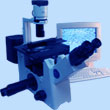
Methods of Investigation
for FP7 partners
and coordinators
|
|||
| Home | |||
| Cytotechnology Group | |||
| Staff | |||
| Methods | |||
| Projects | |||
| Research Results | |||
| Patents | |||
| Image Gallery | |||
| Cooperation | |||
| Contact Us | |||
The Use of Polyamide for Macroencapsules |
|
EASD 38th Annual Meeting. Budapest, Hungary (September 1-5, 2002) THE USE OF POLYAMIDE FOR MACROENCAPSULES FOR BETA-CELLS TRANSPLANTATION Encapsulation allows for transplantation in the absence of immunosuppression. Macrocapsules can be implanted with minimal surgery in different sites of organism. They can also be readily retrieved and produced in a relatively simple way. Different materials have been applied for the production of macrocapsules. The most commonly applied materials are nitro-cellulose acetate, 2-hydroxyethyl methacrylate, acrylonitrile, sodium-methallysulfonate and alginate. We have tested a series of derivations from the polyamide (permissible for medical use), for creation of macrocapsules with pore size up to 1 µm. Isolated rat pancreatic islets were precultured for 6 days and than transplanted in streptozocin-treated (20 mg/kg daily – 3 times) dogs (dogs n=12) intravascularly after diabetes manifestation. We used also macrocapsules from nitro-cellulose acetate with the same pore size (dogs n=6). Insulin independence was observed in 2 dogs transplanted with nitro-cellulose acetate capsules within 8 and 11 days. After that term all animals with such macrocapsules needed additional insulinotherapy to uphold normoglycemia. In 8 dogs with transplanted polyamide capsules insulin independence have been observed within 78±4 days. Pretransplantative level of need in exogenous insulin for dogs with nitro-cellulose capsules was observed to 63±17 days, for dogs with polyamide capsules to 364±38 days. After achievement of full insufficiency of transplantants the animals were put to sleep according to international rules of animals treatment. Microscopic sections from capsules retrieved from sacrified animals were produced and stained with aldehyd-fuchsin. Only in 6 polyamide macrocapsules beta-cells and islet-like structures were found. Thus, polyamide macrocapsules showed higher ability for preservation and function of beta-cells. |
| COOPERATION NEWS | ||
FP7 Programme involves subjects
|
||
| CURRENT RESEARCH | ||
|
||
| 2005-2007 © LBMI |


